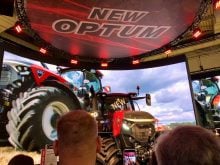Two farm kids from Sheho, Sask., have received an honorable mention with their first entry in the Canadian science fair in June.
Jennifer Hawreluik and Amber Gorgichuk, who are both entering Grade 12 this fall, said their project was required for a school science credit. Since they are from farms they decided to do an agricultural project.
They came up with edible twine because “it would give farmers a market to sell their flax straw, which is normally a waste product and the twine would also aid livestock producers.”
Read Also

Agritechnica Day 2: The future of tractor power, building quicker crop apps and large farms and tech
Agritechnica Day 2: The future of tractor power, building quicker crop apps with Syngenta and large farms and tech
The twine wouldn’t have to be removed from the feed and it wouldn’t cause health problems for animals that eat it.
The two youths gathered flax straw, soaked it and braided it into rope pieces. When wet it could hold 18 kilograms. However, when dry, it wasn’t strong enough to hold a hay bale.
Returning to the drawing board, they threshed whole straw to extract fibre. It had a wool-like texture so they tried it out on a spinning wheel and found they could make an acceptable strand that could be braided into rope.
They conducted weight experiments. While synthetic twine could hold more, their edible flax was strong enough to contain a square bale weighing 23 kg.
Next they fed it to cattle to ensure its edibility.
“They ate the twine like they would eat any other feed,” they said in their report to the science fair.
There were no tests for durability but Hawreluik and Gorgichuk said flax is noted for its longevity. They are looking for a suitable coating to reduce fraying. A coating might also discourage chewing by rats and mice.
They would also like to spin the strands tighter to create a stronger twine.
“Our twine is not commercially available because it is in the minor stages of development,” their report said.
“We would like to conduct more tests and improve the production of the twine.”
They also intend to enter the next national science fair.
While the project has interested Hawreluik, who plans to further her education in livestock agriculture, Gorgichuk said she intends to make a career in medical sciences.














